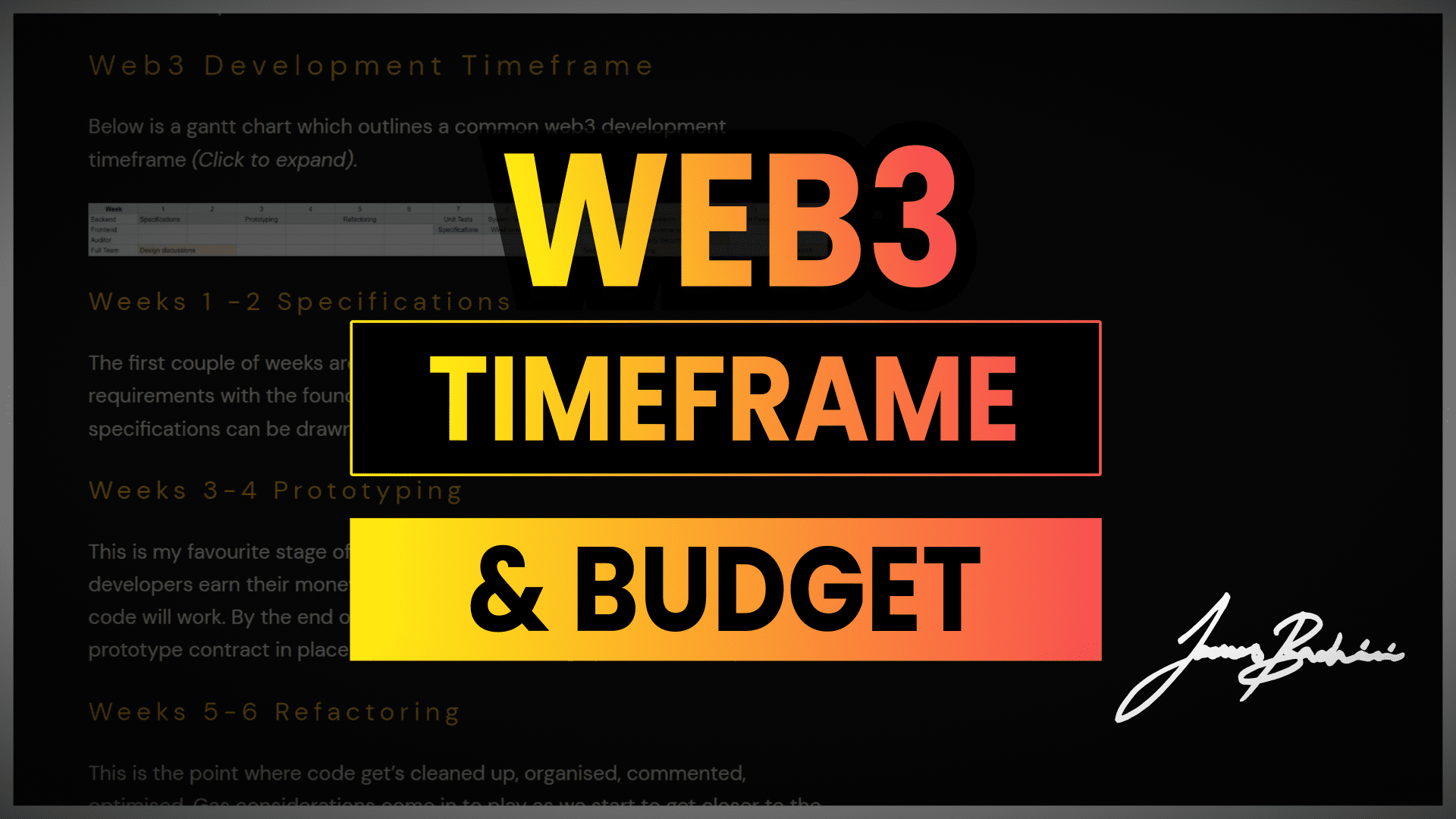In this article I’m going to provide a timeframe, gantt chart and budget costs for web3 development projects.
This assumes a medium sized project for something like a new, innovative DeFi protocol consisting of 5-10 interconnected smart contracts and around 1000 lines of code plus an external audit and dApp frontend. If you are just deploying a token then it can be done in under 30 seconds, if you are building the metaverse Zuck says it will take years and cost $10B+.
The time frame assumes a full-time solidity developer with an external auditing company and a contracted frontend developer. Often a single full-stack developer will do both frontend and backend work which might add a month to the process.

Web3 Development Timeframe
Below is a gantt chart which outlines a common web3 development timeframe (Click to expand).

Weeks 1 -2 Specifications
The first couple of weeks are usually spent discussing the protocol design requirements with the founders and stakeholders in the project. A set of specifications can be drawn up to formalise what is required.
Weeks 3-4 Prototyping
This is my favourite stage of the development process. It is where the best developers earn their money by creatively figuring out and planning how the code will work. By the end of this period there should be a semi-working prototype contract in place which can act as a rough proof of concept.
Weeks 5-6 Refactoring
This is the point where code get’s cleaned up, organised, commented, optimised. Gas considerations come in to play as we start to get closer to the completed contract design structure. At the end of this period the contracts should be polished and in a state where they can be proudly open-sourced.
Weeks 7-8 Testing & Frontends
At this point it is unlikely that anything major will change in the functionality of the contracts so it’s a good time to start frontend development. This is usually starts with concept designs and wireframing.
Weeks 9-10 Testnet Deployment
While the frontend is being completed the solidity developer can deploy the contracts to a testnet so that the frontend devs have something to connect up to. This is often done with an automated deployment script which helps ensure the mainnet deployment will go just as smoothly.
Weeks 11-12 Security Audit
Once the code is deployed to testnet and everything works it’s time to get the external auditing company in. Bare in mind that this should be arranged some time in advance to ensure that the engineers are available. While this is going on the solidity dev will need to be available intermittently to answer questions and it’s a good time to do user interface improvements and tidy up things like the documentation.
Weeks 13-14 Mainnet Launch
Once the audit is complete there will likely be a week where the solidity developer is going through the report and completing fixes and recommendations. This is the final step before mainnet launch where it’s all hands on deck and there’s a lot of work on marketing and promotion.
Web3 Development Budget
This is a rough budget that’s aimed at being mid-range for the average development. Certain factors such as geographic location of the developers can play a big part in how much it will cost. Average salaries in San Francisco for Solidity developers are more than double what they are in other parts of the world.
This web3 development budget is based on an experienced Solidity developer (average annual salary is around $250,000). Frontend contractor ($60/hour) and a mid-tier auditor.
Auditing firms vary in price and quality greatly and I’d recommend reading the reports of previous audits to get a feel for the value you will be receiving for the cost. I’ve had quotes ranging from $3,000-$120,000 for the exact same code base.
Costings (USD)
| Blockchain developer 14 weeks | $5,000/week | $70,000 |
| Frontend contractor 6 weeks | $2,500/week | $15,000 |
| Security Auditor 2 weeks | $15,000/week | $30,000 |
| Total Cost | $115,000 |
Some other costs to consider are premium domain names, infrastructure (AWS), marketing, liquidity provisions, community management, accounting.
The biggest cost is likely to be marketing as you can build something and there’s no guarantee anyone will care. A significant marketing budget can help build hype and interest in a new project.
Note that this is a generalization and web3 development timeframes and costs will vary from project to project.


